ECN2005: Factors Creating Wage Differences in UK, 2019-20
VerifiedAdded on 2022/08/30
|57
|15651
|24
Report
AI Summary
This report investigates the factors contributing to wage disparities in the UK, employing econometric techniques to analyze data from the Labour Force Survey. The study examines the influence of various factors, including employment type (full-time vs. part-time, agency work), sector (public vs. private), gender, education, ethnicity, and other demographic and employment-related variables, on wage levels. The research uses independent two-sample t-tests and regression analysis to identify significant relationships and quantify the impact of these factors on wage differences. The findings reveal statistically significant differences in wages based on employment characteristics and gender, and regression models highlight the interplay of factors such as occupation, education, age, and continuous employment on wage determination, with separate analyses for males and females. The study confirms the existence of a gender wage gap and explores the roles of various factors in explaining it, contributing to a deeper understanding of wage inequality in the UK labor market.
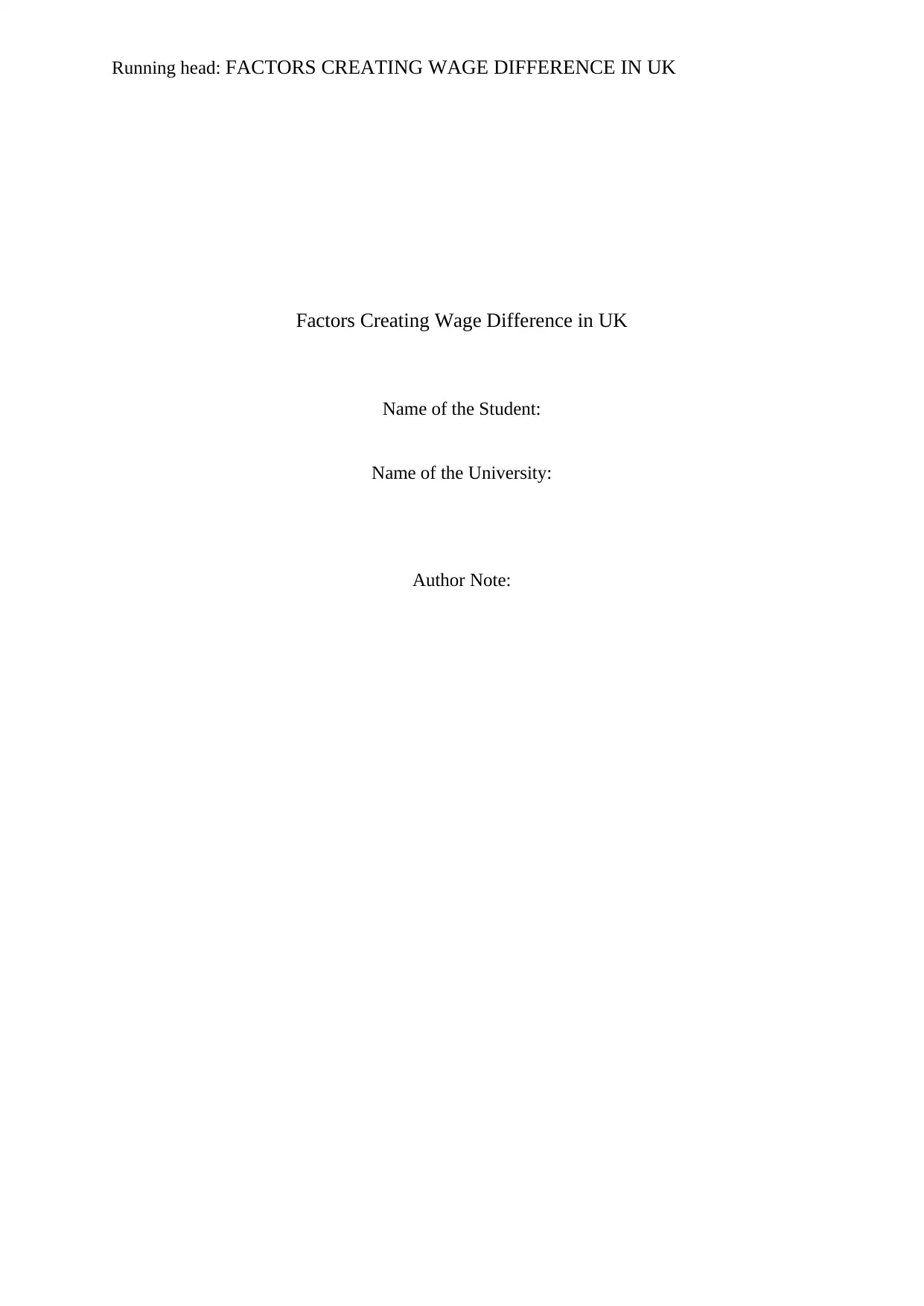
Running head: FACTORS CREATING WAGE DIFFERENCE IN UK
Factors Creating Wage Difference in UK
Name of the Student:
Name of the University:
Author Note:
Factors Creating Wage Difference in UK
Name of the Student:
Name of the University:
Author Note:
Paraphrase This Document
Need a fresh take? Get an instant paraphrase of this document with our AI Paraphraser
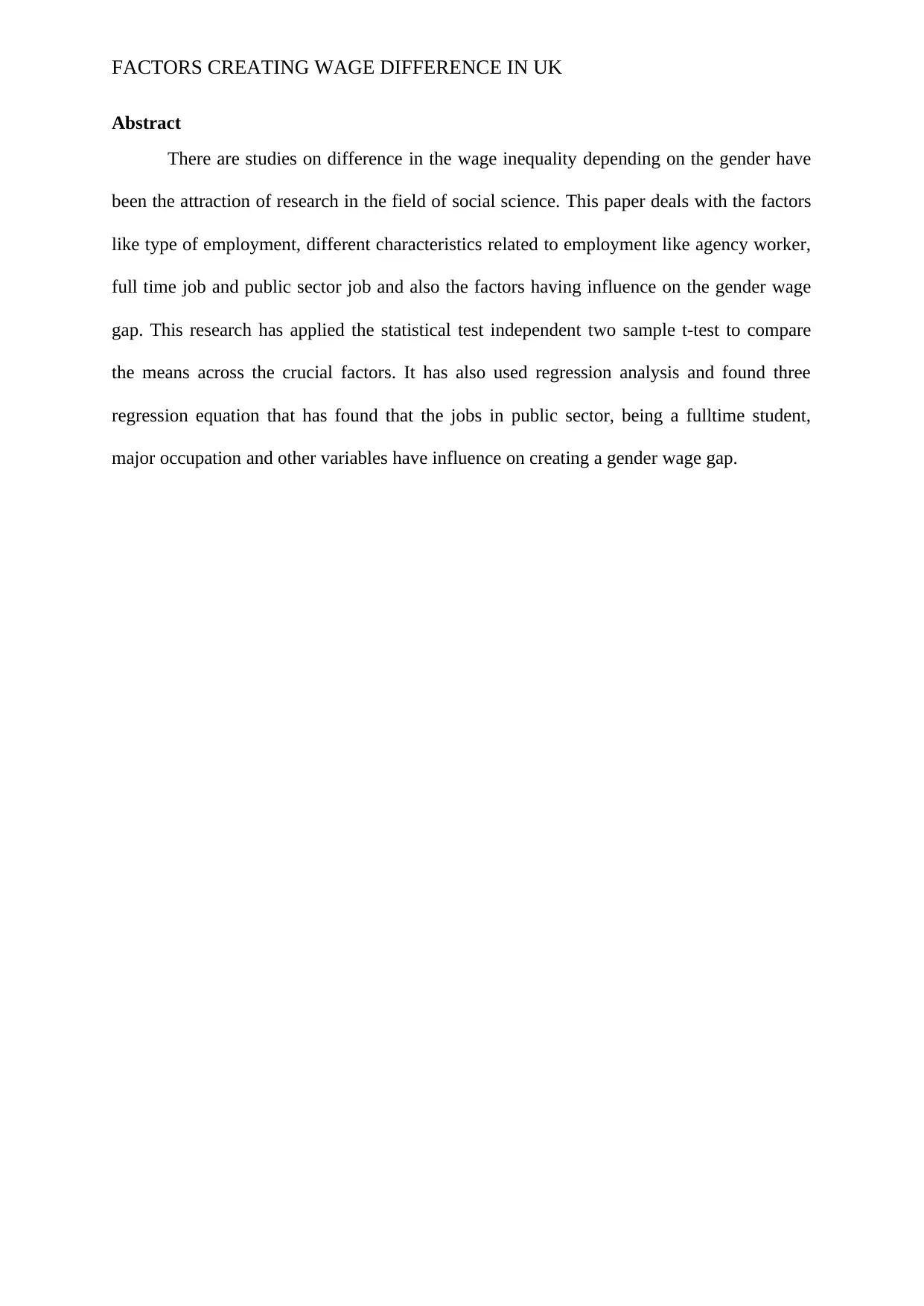
FACTORS CREATING WAGE DIFFERENCE IN UK
Abstract
There are studies on difference in the wage inequality depending on the gender have
been the attraction of research in the field of social science. This paper deals with the factors
like type of employment, different characteristics related to employment like agency worker,
full time job and public sector job and also the factors having influence on the gender wage
gap. This research has applied the statistical test independent two sample t-test to compare
the means across the crucial factors. It has also used regression analysis and found three
regression equation that has found that the jobs in public sector, being a fulltime student,
major occupation and other variables have influence on creating a gender wage gap.
Abstract
There are studies on difference in the wage inequality depending on the gender have
been the attraction of research in the field of social science. This paper deals with the factors
like type of employment, different characteristics related to employment like agency worker,
full time job and public sector job and also the factors having influence on the gender wage
gap. This research has applied the statistical test independent two sample t-test to compare
the means across the crucial factors. It has also used regression analysis and found three
regression equation that has found that the jobs in public sector, being a fulltime student,
major occupation and other variables have influence on creating a gender wage gap.
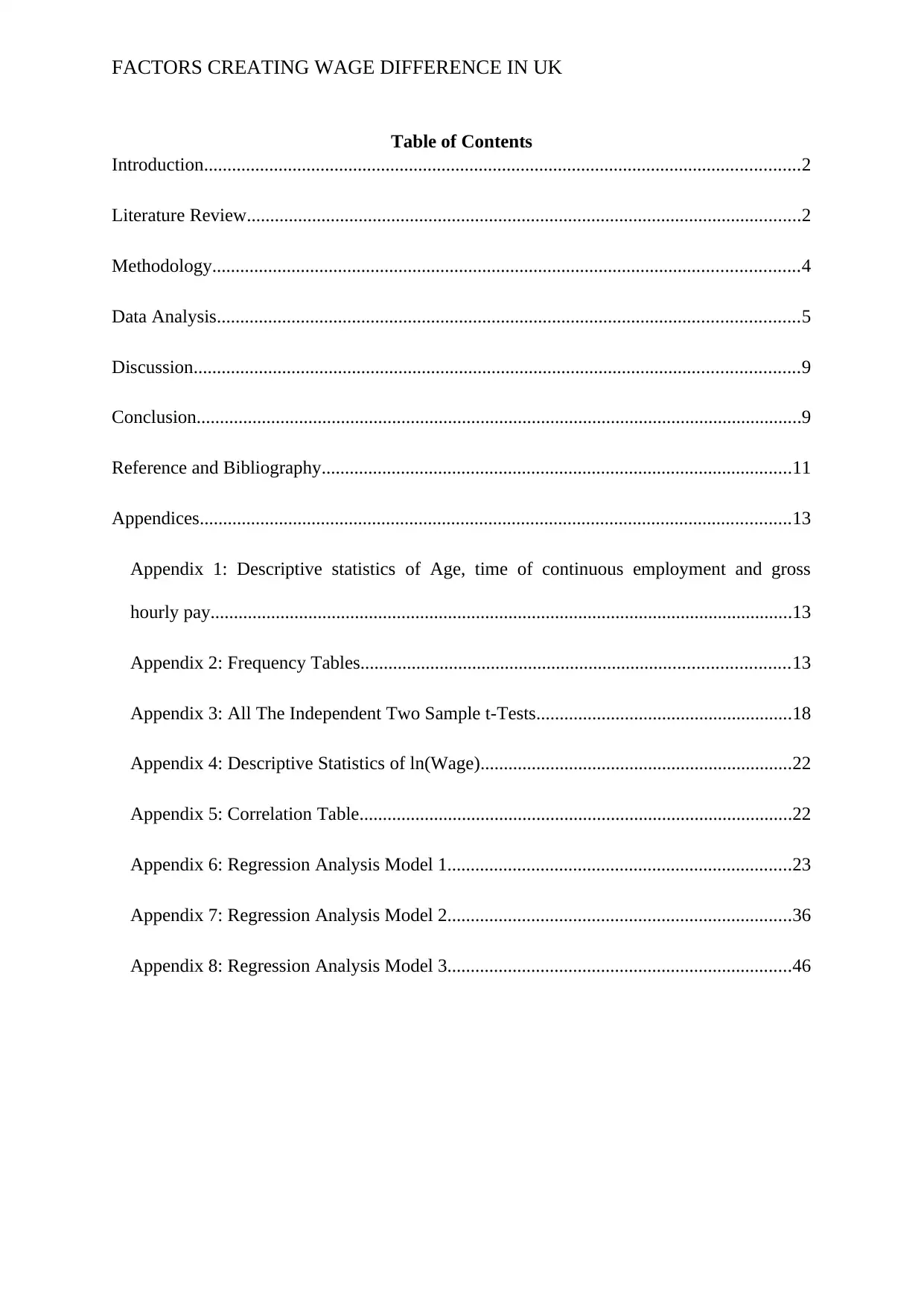
FACTORS CREATING WAGE DIFFERENCE IN UK
Table of Contents
Introduction................................................................................................................................2
Literature Review.......................................................................................................................2
Methodology..............................................................................................................................4
Data Analysis.............................................................................................................................5
Discussion..................................................................................................................................9
Conclusion..................................................................................................................................9
Reference and Bibliography.....................................................................................................11
Appendices...............................................................................................................................13
Appendix 1: Descriptive statistics of Age, time of continuous employment and gross
hourly pay.............................................................................................................................13
Appendix 2: Frequency Tables............................................................................................13
Appendix 3: All The Independent Two Sample t-Tests.......................................................18
Appendix 4: Descriptive Statistics of ln(Wage)...................................................................22
Appendix 5: Correlation Table.............................................................................................22
Appendix 6: Regression Analysis Model 1..........................................................................23
Appendix 7: Regression Analysis Model 2..........................................................................36
Appendix 8: Regression Analysis Model 3..........................................................................46
Table of Contents
Introduction................................................................................................................................2
Literature Review.......................................................................................................................2
Methodology..............................................................................................................................4
Data Analysis.............................................................................................................................5
Discussion..................................................................................................................................9
Conclusion..................................................................................................................................9
Reference and Bibliography.....................................................................................................11
Appendices...............................................................................................................................13
Appendix 1: Descriptive statistics of Age, time of continuous employment and gross
hourly pay.............................................................................................................................13
Appendix 2: Frequency Tables............................................................................................13
Appendix 3: All The Independent Two Sample t-Tests.......................................................18
Appendix 4: Descriptive Statistics of ln(Wage)...................................................................22
Appendix 5: Correlation Table.............................................................................................22
Appendix 6: Regression Analysis Model 1..........................................................................23
Appendix 7: Regression Analysis Model 2..........................................................................36
Appendix 8: Regression Analysis Model 3..........................................................................46
⊘ This is a preview!⊘
Do you want full access?
Subscribe today to unlock all pages.

Trusted by 1+ million students worldwide
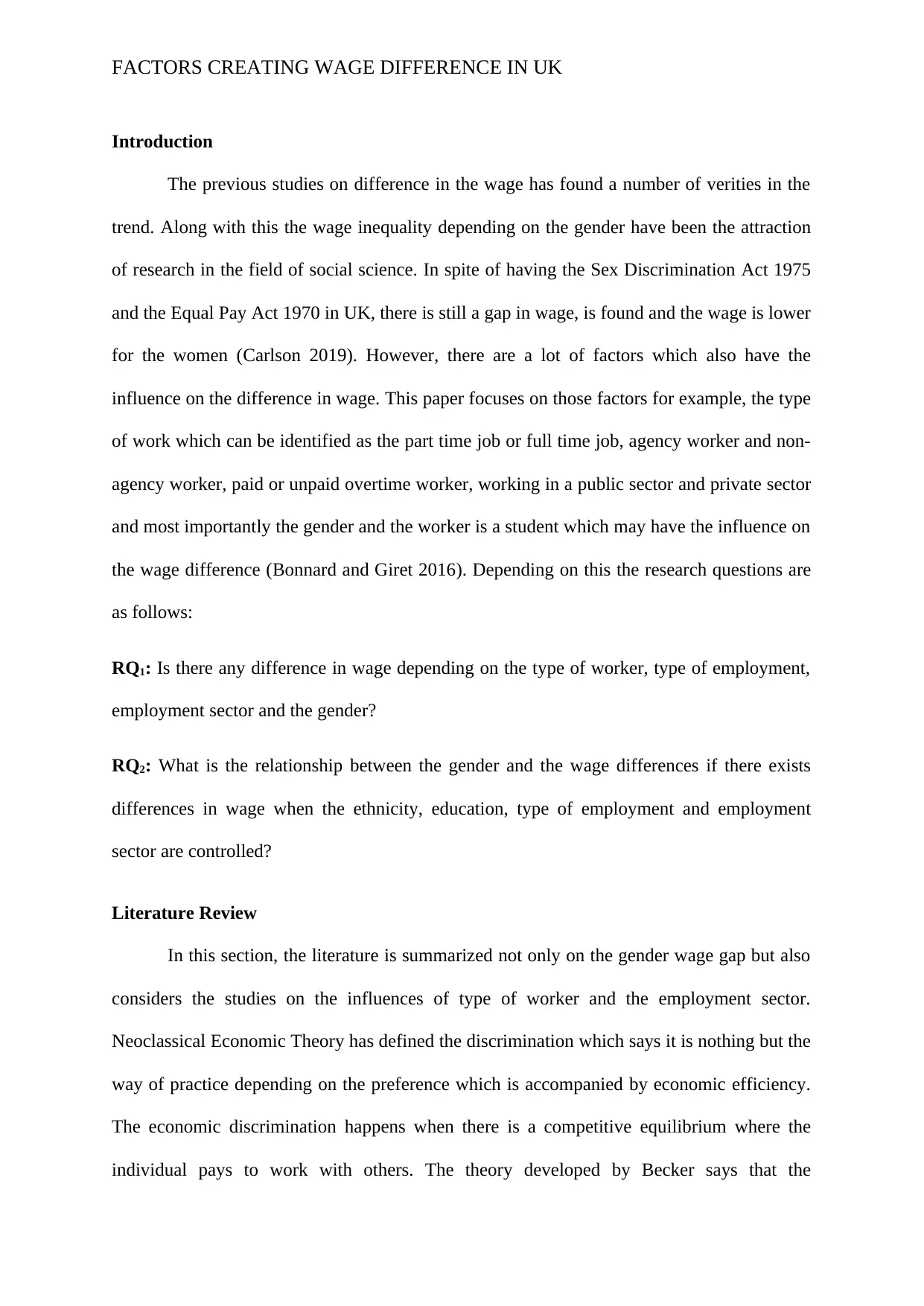
FACTORS CREATING WAGE DIFFERENCE IN UK
Introduction
The previous studies on difference in the wage has found a number of verities in the
trend. Along with this the wage inequality depending on the gender have been the attraction
of research in the field of social science. In spite of having the Sex Discrimination Act 1975
and the Equal Pay Act 1970 in UK, there is still a gap in wage, is found and the wage is lower
for the women (Carlson 2019). However, there are a lot of factors which also have the
influence on the difference in wage. This paper focuses on those factors for example, the type
of work which can be identified as the part time job or full time job, agency worker and non-
agency worker, paid or unpaid overtime worker, working in a public sector and private sector
and most importantly the gender and the worker is a student which may have the influence on
the wage difference (Bonnard and Giret 2016). Depending on this the research questions are
as follows:
RQ1: Is there any difference in wage depending on the type of worker, type of employment,
employment sector and the gender?
RQ2: What is the relationship between the gender and the wage differences if there exists
differences in wage when the ethnicity, education, type of employment and employment
sector are controlled?
Literature Review
In this section, the literature is summarized not only on the gender wage gap but also
considers the studies on the influences of type of worker and the employment sector.
Neoclassical Economic Theory has defined the discrimination which says it is nothing but the
way of practice depending on the preference which is accompanied by economic efficiency.
The economic discrimination happens when there is a competitive equilibrium where the
individual pays to work with others. The theory developed by Becker says that the
Introduction
The previous studies on difference in the wage has found a number of verities in the
trend. Along with this the wage inequality depending on the gender have been the attraction
of research in the field of social science. In spite of having the Sex Discrimination Act 1975
and the Equal Pay Act 1970 in UK, there is still a gap in wage, is found and the wage is lower
for the women (Carlson 2019). However, there are a lot of factors which also have the
influence on the difference in wage. This paper focuses on those factors for example, the type
of work which can be identified as the part time job or full time job, agency worker and non-
agency worker, paid or unpaid overtime worker, working in a public sector and private sector
and most importantly the gender and the worker is a student which may have the influence on
the wage difference (Bonnard and Giret 2016). Depending on this the research questions are
as follows:
RQ1: Is there any difference in wage depending on the type of worker, type of employment,
employment sector and the gender?
RQ2: What is the relationship between the gender and the wage differences if there exists
differences in wage when the ethnicity, education, type of employment and employment
sector are controlled?
Literature Review
In this section, the literature is summarized not only on the gender wage gap but also
considers the studies on the influences of type of worker and the employment sector.
Neoclassical Economic Theory has defined the discrimination which says it is nothing but the
way of practice depending on the preference which is accompanied by economic efficiency.
The economic discrimination happens when there is a competitive equilibrium where the
individual pays to work with others. The theory developed by Becker says that the
Paraphrase This Document
Need a fresh take? Get an instant paraphrase of this document with our AI Paraphraser
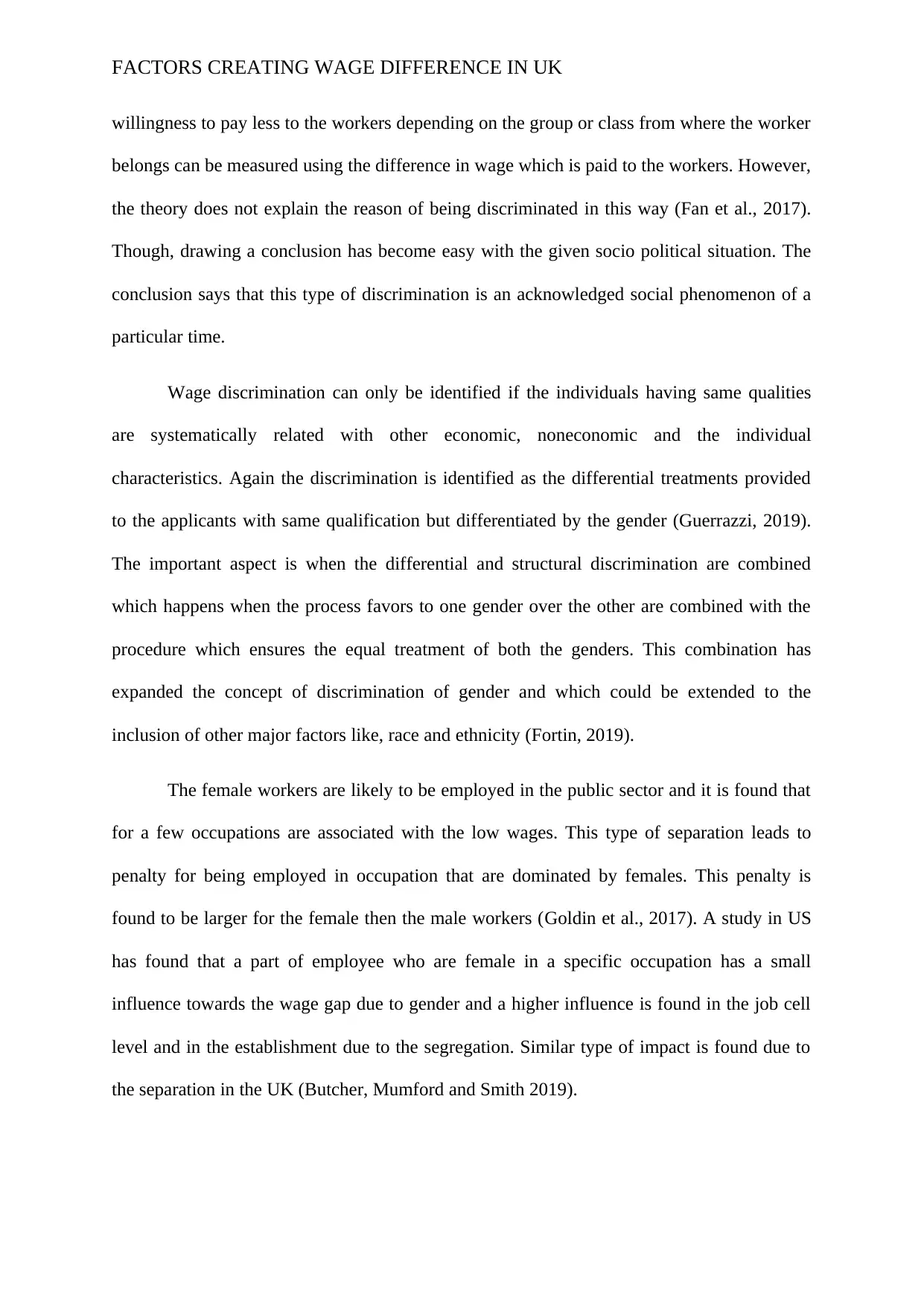
FACTORS CREATING WAGE DIFFERENCE IN UK
willingness to pay less to the workers depending on the group or class from where the worker
belongs can be measured using the difference in wage which is paid to the workers. However,
the theory does not explain the reason of being discriminated in this way (Fan et al., 2017).
Though, drawing a conclusion has become easy with the given socio political situation. The
conclusion says that this type of discrimination is an acknowledged social phenomenon of a
particular time.
Wage discrimination can only be identified if the individuals having same qualities
are systematically related with other economic, noneconomic and the individual
characteristics. Again the discrimination is identified as the differential treatments provided
to the applicants with same qualification but differentiated by the gender (Guerrazzi, 2019).
The important aspect is when the differential and structural discrimination are combined
which happens when the process favors to one gender over the other are combined with the
procedure which ensures the equal treatment of both the genders. This combination has
expanded the concept of discrimination of gender and which could be extended to the
inclusion of other major factors like, race and ethnicity (Fortin, 2019).
The female workers are likely to be employed in the public sector and it is found that
for a few occupations are associated with the low wages. This type of separation leads to
penalty for being employed in occupation that are dominated by females. This penalty is
found to be larger for the female then the male workers (Goldin et al., 2017). A study in US
has found that a part of employee who are female in a specific occupation has a small
influence towards the wage gap due to gender and a higher influence is found in the job cell
level and in the establishment due to the segregation. Similar type of impact is found due to
the separation in the UK (Butcher, Mumford and Smith 2019).
willingness to pay less to the workers depending on the group or class from where the worker
belongs can be measured using the difference in wage which is paid to the workers. However,
the theory does not explain the reason of being discriminated in this way (Fan et al., 2017).
Though, drawing a conclusion has become easy with the given socio political situation. The
conclusion says that this type of discrimination is an acknowledged social phenomenon of a
particular time.
Wage discrimination can only be identified if the individuals having same qualities
are systematically related with other economic, noneconomic and the individual
characteristics. Again the discrimination is identified as the differential treatments provided
to the applicants with same qualification but differentiated by the gender (Guerrazzi, 2019).
The important aspect is when the differential and structural discrimination are combined
which happens when the process favors to one gender over the other are combined with the
procedure which ensures the equal treatment of both the genders. This combination has
expanded the concept of discrimination of gender and which could be extended to the
inclusion of other major factors like, race and ethnicity (Fortin, 2019).
The female workers are likely to be employed in the public sector and it is found that
for a few occupations are associated with the low wages. This type of separation leads to
penalty for being employed in occupation that are dominated by females. This penalty is
found to be larger for the female then the male workers (Goldin et al., 2017). A study in US
has found that a part of employee who are female in a specific occupation has a small
influence towards the wage gap due to gender and a higher influence is found in the job cell
level and in the establishment due to the segregation. Similar type of impact is found due to
the separation in the UK (Butcher, Mumford and Smith 2019).
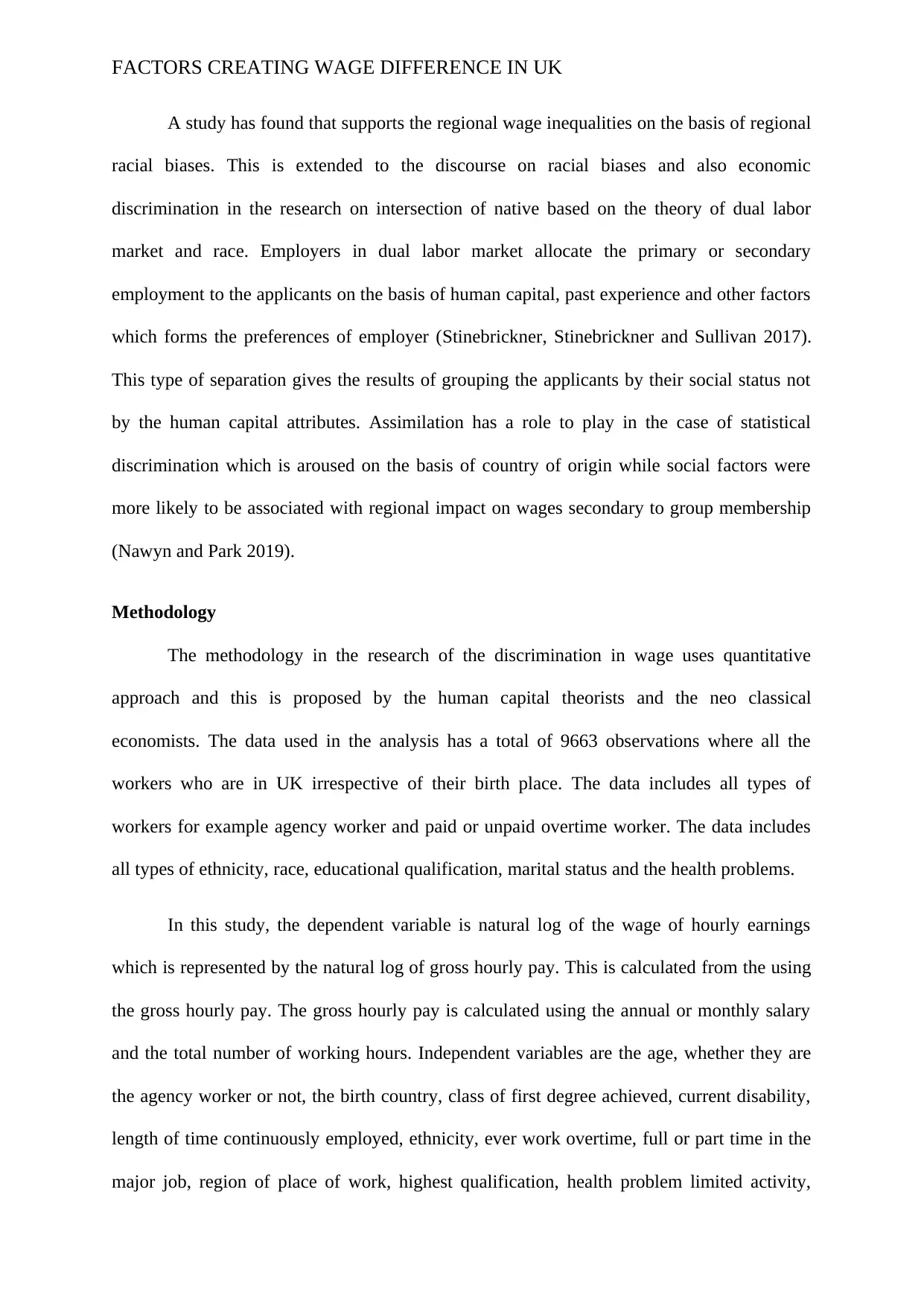
FACTORS CREATING WAGE DIFFERENCE IN UK
A study has found that supports the regional wage inequalities on the basis of regional
racial biases. This is extended to the discourse on racial biases and also economic
discrimination in the research on intersection of native based on the theory of dual labor
market and race. Employers in dual labor market allocate the primary or secondary
employment to the applicants on the basis of human capital, past experience and other factors
which forms the preferences of employer (Stinebrickner, Stinebrickner and Sullivan 2017).
This type of separation gives the results of grouping the applicants by their social status not
by the human capital attributes. Assimilation has a role to play in the case of statistical
discrimination which is aroused on the basis of country of origin while social factors were
more likely to be associated with regional impact on wages secondary to group membership
(Nawyn and Park 2019).
Methodology
The methodology in the research of the discrimination in wage uses quantitative
approach and this is proposed by the human capital theorists and the neo classical
economists. The data used in the analysis has a total of 9663 observations where all the
workers who are in UK irrespective of their birth place. The data includes all types of
workers for example agency worker and paid or unpaid overtime worker. The data includes
all types of ethnicity, race, educational qualification, marital status and the health problems.
In this study, the dependent variable is natural log of the wage of hourly earnings
which is represented by the natural log of gross hourly pay. This is calculated from the using
the gross hourly pay. The gross hourly pay is calculated using the annual or monthly salary
and the total number of working hours. Independent variables are the age, whether they are
the agency worker or not, the birth country, class of first degree achieved, current disability,
length of time continuously employed, ethnicity, ever work overtime, full or part time in the
major job, region of place of work, highest qualification, health problem limited activity,
A study has found that supports the regional wage inequalities on the basis of regional
racial biases. This is extended to the discourse on racial biases and also economic
discrimination in the research on intersection of native based on the theory of dual labor
market and race. Employers in dual labor market allocate the primary or secondary
employment to the applicants on the basis of human capital, past experience and other factors
which forms the preferences of employer (Stinebrickner, Stinebrickner and Sullivan 2017).
This type of separation gives the results of grouping the applicants by their social status not
by the human capital attributes. Assimilation has a role to play in the case of statistical
discrimination which is aroused on the basis of country of origin while social factors were
more likely to be associated with regional impact on wages secondary to group membership
(Nawyn and Park 2019).
Methodology
The methodology in the research of the discrimination in wage uses quantitative
approach and this is proposed by the human capital theorists and the neo classical
economists. The data used in the analysis has a total of 9663 observations where all the
workers who are in UK irrespective of their birth place. The data includes all types of
workers for example agency worker and paid or unpaid overtime worker. The data includes
all types of ethnicity, race, educational qualification, marital status and the health problems.
In this study, the dependent variable is natural log of the wage of hourly earnings
which is represented by the natural log of gross hourly pay. This is calculated from the using
the gross hourly pay. The gross hourly pay is calculated using the annual or monthly salary
and the total number of working hours. Independent variables are the age, whether they are
the agency worker or not, the birth country, class of first degree achieved, current disability,
length of time continuously employed, ethnicity, ever work overtime, full or part time in the
major job, region of place of work, highest qualification, health problem limited activity,
⊘ This is a preview!⊘
Do you want full access?
Subscribe today to unlock all pages.

Trusted by 1+ million students worldwide
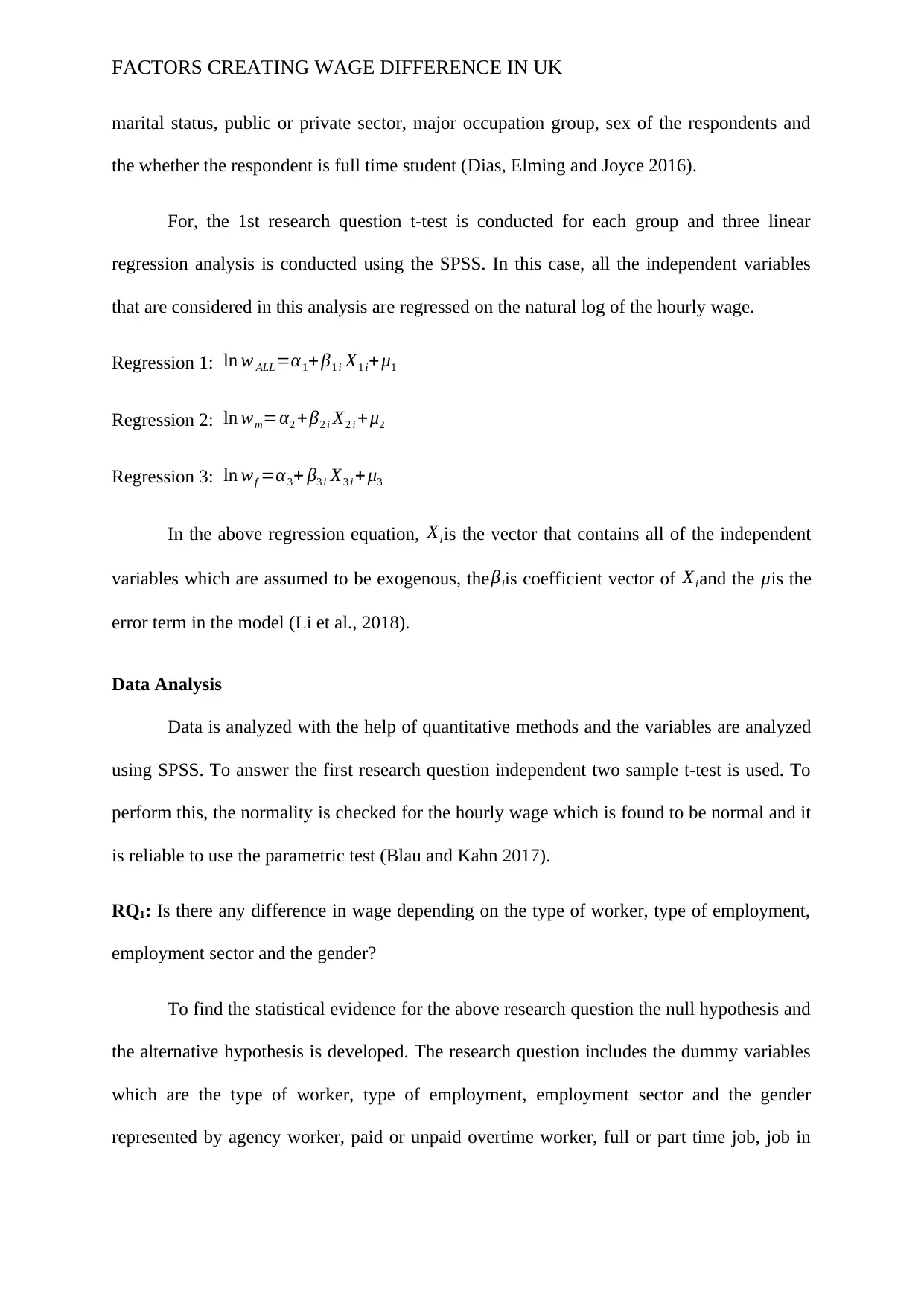
FACTORS CREATING WAGE DIFFERENCE IN UK
marital status, public or private sector, major occupation group, sex of the respondents and
the whether the respondent is full time student (Dias, Elming and Joyce 2016).
For, the 1st research question t-test is conducted for each group and three linear
regression analysis is conducted using the SPSS. In this case, all the independent variables
that are considered in this analysis are regressed on the natural log of the hourly wage.
Regression 1: ln w ALL=α1+ β1 i X1 i+ μ1
Regression 2: ln wm=α2 +β2 i X2 i + μ2
Regression 3: ln wf =α3+ β3 i X3 i +μ3
In the above regression equation, Xiis the vector that contains all of the independent
variables which are assumed to be exogenous, theβiis coefficient vector of Xiand the μis the
error term in the model (Li et al., 2018).
Data Analysis
Data is analyzed with the help of quantitative methods and the variables are analyzed
using SPSS. To answer the first research question independent two sample t-test is used. To
perform this, the normality is checked for the hourly wage which is found to be normal and it
is reliable to use the parametric test (Blau and Kahn 2017).
RQ1: Is there any difference in wage depending on the type of worker, type of employment,
employment sector and the gender?
To find the statistical evidence for the above research question the null hypothesis and
the alternative hypothesis is developed. The research question includes the dummy variables
which are the type of worker, type of employment, employment sector and the gender
represented by agency worker, paid or unpaid overtime worker, full or part time job, job in
marital status, public or private sector, major occupation group, sex of the respondents and
the whether the respondent is full time student (Dias, Elming and Joyce 2016).
For, the 1st research question t-test is conducted for each group and three linear
regression analysis is conducted using the SPSS. In this case, all the independent variables
that are considered in this analysis are regressed on the natural log of the hourly wage.
Regression 1: ln w ALL=α1+ β1 i X1 i+ μ1
Regression 2: ln wm=α2 +β2 i X2 i + μ2
Regression 3: ln wf =α3+ β3 i X3 i +μ3
In the above regression equation, Xiis the vector that contains all of the independent
variables which are assumed to be exogenous, theβiis coefficient vector of Xiand the μis the
error term in the model (Li et al., 2018).
Data Analysis
Data is analyzed with the help of quantitative methods and the variables are analyzed
using SPSS. To answer the first research question independent two sample t-test is used. To
perform this, the normality is checked for the hourly wage which is found to be normal and it
is reliable to use the parametric test (Blau and Kahn 2017).
RQ1: Is there any difference in wage depending on the type of worker, type of employment,
employment sector and the gender?
To find the statistical evidence for the above research question the null hypothesis and
the alternative hypothesis is developed. The research question includes the dummy variables
which are the type of worker, type of employment, employment sector and the gender
represented by agency worker, paid or unpaid overtime worker, full or part time job, job in
Paraphrase This Document
Need a fresh take? Get an instant paraphrase of this document with our AI Paraphraser
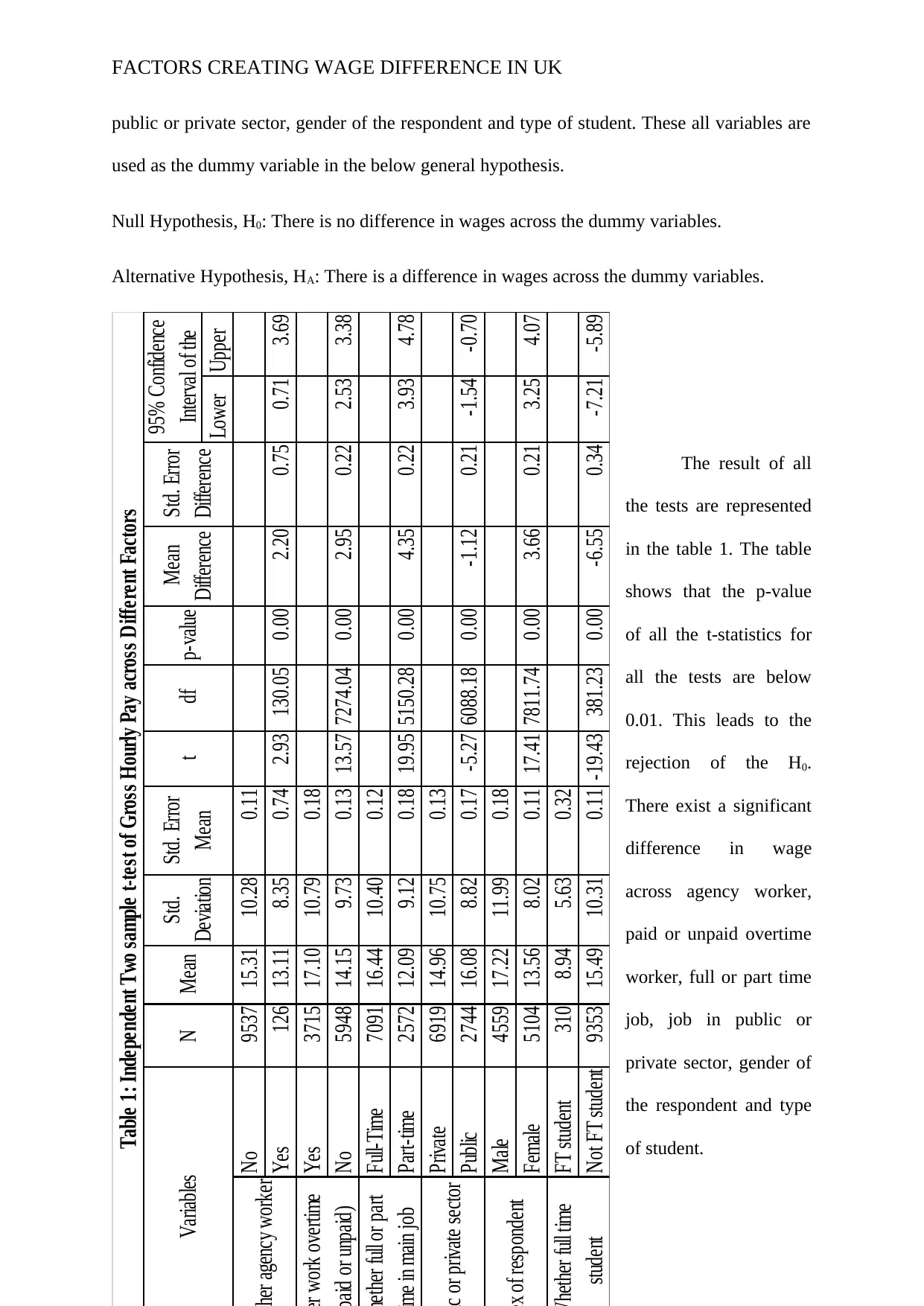
FACTORS CREATING WAGE DIFFERENCE IN UK
public or private sector, gender of the respondent and type of student. These all variables are
used as the dummy variable in the below general hypothesis.
Null Hypothesis, H0: There is no difference in wages across the dummy variables.
Alternative Hypothesis, HA: There is a difference in wages across the dummy variables.
The result of all
the tests are represented
in the table 1. The table
shows that the p-value
of all the t-statistics for
all the tests are below
0.01. This leads to the
rejection of the H0.
There exist a significant
difference in wage
across agency worker,
paid or unpaid overtime
worker, full or part time
job, job in public or
private sector, gender of
the respondent and type
of student.
Lower Upper
No 9537 15.31 10.28 0.11
Yes 126 13.11 8.35 0.74 2.93 130.05 0.00 2.20 0.75 0.71 3.69
Yes 3715 17.10 10.79 0.18
No 5948 14.15 9.73 0.13 13.57 7274.04 0.00 2.95 0.22 2.53 3.38
Full-Time 7091 16.44 10.40 0.12
Part-time 2572 12.09 9.12 0.18 19.95 5150.28 0.00 4.35 0.22 3.93 4.78
Private 6919 14.96 10.75 0.13
Public 2744 16.08 8.82 0.17 -5.27 6088.18 0.00 -1.12 0.21 -1.54 -0.70
Male 4559 17.22 11.99 0.18
Female 5104 13.56 8.02 0.11 17.41 7811.74 0.00 3.66 0.21 3.25 4.07
FT student 310 8.94 5.63 0.32
Not FT student 9353 15.49 10.31 0.11 -19.43 381.23 0.00 -6.55 0.34 -7.21 -5.89
er agency worker
r work overtime
aid or unpaid)
ether full or part
e in main job
or private sector
x of respondent
hether full time
student
t df p-value Mean
Difference
Std. Error
Difference
95% Confidence
Interval of theVariables N Mean Std.
Deviation
Std. Error
Mean
Table 1: Independent Two sample t-test of Gross Hourly Pay across Different Factors
public or private sector, gender of the respondent and type of student. These all variables are
used as the dummy variable in the below general hypothesis.
Null Hypothesis, H0: There is no difference in wages across the dummy variables.
Alternative Hypothesis, HA: There is a difference in wages across the dummy variables.
The result of all
the tests are represented
in the table 1. The table
shows that the p-value
of all the t-statistics for
all the tests are below
0.01. This leads to the
rejection of the H0.
There exist a significant
difference in wage
across agency worker,
paid or unpaid overtime
worker, full or part time
job, job in public or
private sector, gender of
the respondent and type
of student.
Lower Upper
No 9537 15.31 10.28 0.11
Yes 126 13.11 8.35 0.74 2.93 130.05 0.00 2.20 0.75 0.71 3.69
Yes 3715 17.10 10.79 0.18
No 5948 14.15 9.73 0.13 13.57 7274.04 0.00 2.95 0.22 2.53 3.38
Full-Time 7091 16.44 10.40 0.12
Part-time 2572 12.09 9.12 0.18 19.95 5150.28 0.00 4.35 0.22 3.93 4.78
Private 6919 14.96 10.75 0.13
Public 2744 16.08 8.82 0.17 -5.27 6088.18 0.00 -1.12 0.21 -1.54 -0.70
Male 4559 17.22 11.99 0.18
Female 5104 13.56 8.02 0.11 17.41 7811.74 0.00 3.66 0.21 3.25 4.07
FT student 310 8.94 5.63 0.32
Not FT student 9353 15.49 10.31 0.11 -19.43 381.23 0.00 -6.55 0.34 -7.21 -5.89
er agency worker
r work overtime
aid or unpaid)
ether full or part
e in main job
or private sector
x of respondent
hether full time
student
t df p-value Mean
Difference
Std. Error
Difference
95% Confidence
Interval of theVariables N Mean Std.
Deviation
Std. Error
Mean
Table 1: Independent Two sample t-test of Gross Hourly Pay across Different Factors
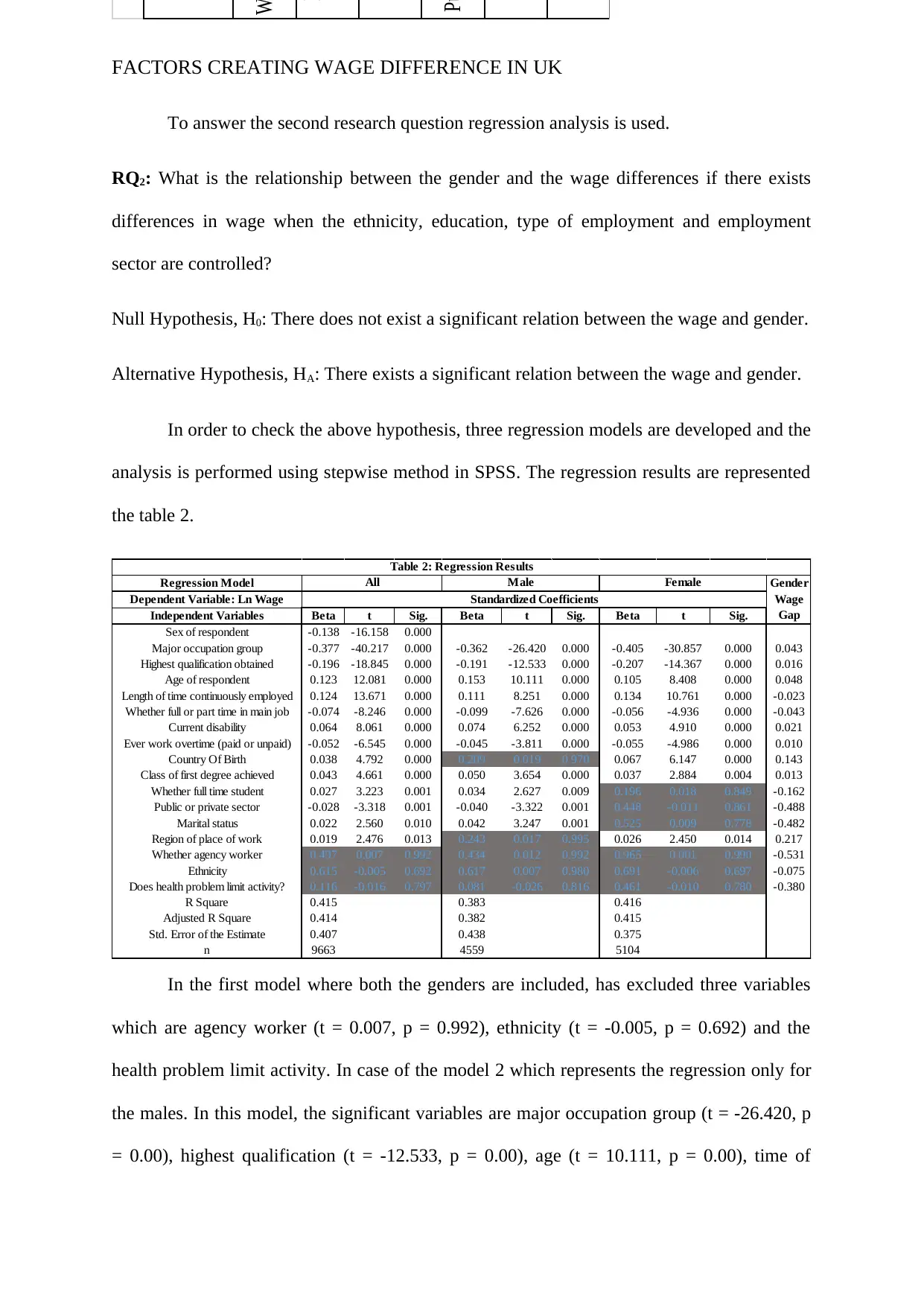
FACTORS CREATING WAGE DIFFERENCE IN UK
To answer the second research question regression analysis is used.
RQ2: What is the relationship between the gender and the wage differences if there exists
differences in wage when the ethnicity, education, type of employment and employment
sector are controlled?
Null Hypothesis, H0: There does not exist a significant relation between the wage and gender.
Alternative Hypothesis, HA: There exists a significant relation between the wage and gender.
In order to check the above hypothesis, three regression models are developed and the
analysis is performed using stepwise method in SPSS. The regression results are represented
the table 2.
Regression Model
Dependent Variable: Ln Wage
Independent Variables Beta t Sig. Beta t Sig. Beta t Sig.
Sex of respondent -0.138 -16.158 0.000
Major occupation group -0.377 -40.217 0.000 -0.362 -26.420 0.000 -0.405 -30.857 0.000 0.043
Highest qualification obtained -0.196 -18.845 0.000 -0.191 -12.533 0.000 -0.207 -14.367 0.000 0.016
Age of respondent 0.123 12.081 0.000 0.153 10.111 0.000 0.105 8.408 0.000 0.048
Length of time continuously employed 0.124 13.671 0.000 0.111 8.251 0.000 0.134 10.761 0.000 -0.023
Whether full or part time in main job -0.074 -8.246 0.000 -0.099 -7.626 0.000 -0.056 -4.936 0.000 -0.043
Current disability 0.064 8.061 0.000 0.074 6.252 0.000 0.053 4.910 0.000 0.021
Ever work overtime (paid or unpaid) -0.052 -6.545 0.000 -0.045 -3.811 0.000 -0.055 -4.986 0.000 0.010
Country Of Birth 0.038 4.792 0.000 0.209 0.019 0.970 0.067 6.147 0.000 0.143
Class of first degree achieved 0.043 4.661 0.000 0.050 3.654 0.000 0.037 2.884 0.004 0.013
Whether full time student 0.027 3.223 0.001 0.034 2.627 0.009 0.196 0.018 0.849 -0.162
Public or private sector -0.028 -3.318 0.001 -0.040 -3.322 0.001 0.448 -0.011 0.861 -0.488
Marital status 0.022 2.560 0.010 0.042 3.247 0.001 0.525 0.009 0.778 -0.482
Region of place of work 0.019 2.476 0.013 0.243 0.017 0.995 0.026 2.450 0.014 0.217
Whether agency worker 0.497 0.007 0.992 0.434 0.012 0.992 0.965 0.001 0.990 -0.531
Ethnicity 0.615 -0.005 0.692 0.617 0.007 0.980 0.691 -0.006 0.697 -0.075
Does health problem limit activity? 0.116 -0.016 0.797 0.081 -0.026 0.816 0.461 -0.010 0.780 -0.380
R Square 0.415 0.383 0.416
Adjusted R Square 0.414 0.382 0.415
Std. Error of the Estimate 0.407 0.438 0.375
n 9663 4559 5104
Female
Standardized Coefficients
Gender
Wage
Gap
Table 2: Regression Results
MaleAll
In the first model where both the genders are included, has excluded three variables
which are agency worker (t = 0.007, p = 0.992), ethnicity (t = -0.005, p = 0.692) and the
health problem limit activity. In case of the model 2 which represents the regression only for
the males. In this model, the significant variables are major occupation group (t = -26.420, p
= 0.00), highest qualification (t = -12.533, p = 0.00), age (t = 10.111, p = 0.00), time of
W
E
Pu
To answer the second research question regression analysis is used.
RQ2: What is the relationship between the gender and the wage differences if there exists
differences in wage when the ethnicity, education, type of employment and employment
sector are controlled?
Null Hypothesis, H0: There does not exist a significant relation between the wage and gender.
Alternative Hypothesis, HA: There exists a significant relation between the wage and gender.
In order to check the above hypothesis, three regression models are developed and the
analysis is performed using stepwise method in SPSS. The regression results are represented
the table 2.
Regression Model
Dependent Variable: Ln Wage
Independent Variables Beta t Sig. Beta t Sig. Beta t Sig.
Sex of respondent -0.138 -16.158 0.000
Major occupation group -0.377 -40.217 0.000 -0.362 -26.420 0.000 -0.405 -30.857 0.000 0.043
Highest qualification obtained -0.196 -18.845 0.000 -0.191 -12.533 0.000 -0.207 -14.367 0.000 0.016
Age of respondent 0.123 12.081 0.000 0.153 10.111 0.000 0.105 8.408 0.000 0.048
Length of time continuously employed 0.124 13.671 0.000 0.111 8.251 0.000 0.134 10.761 0.000 -0.023
Whether full or part time in main job -0.074 -8.246 0.000 -0.099 -7.626 0.000 -0.056 -4.936 0.000 -0.043
Current disability 0.064 8.061 0.000 0.074 6.252 0.000 0.053 4.910 0.000 0.021
Ever work overtime (paid or unpaid) -0.052 -6.545 0.000 -0.045 -3.811 0.000 -0.055 -4.986 0.000 0.010
Country Of Birth 0.038 4.792 0.000 0.209 0.019 0.970 0.067 6.147 0.000 0.143
Class of first degree achieved 0.043 4.661 0.000 0.050 3.654 0.000 0.037 2.884 0.004 0.013
Whether full time student 0.027 3.223 0.001 0.034 2.627 0.009 0.196 0.018 0.849 -0.162
Public or private sector -0.028 -3.318 0.001 -0.040 -3.322 0.001 0.448 -0.011 0.861 -0.488
Marital status 0.022 2.560 0.010 0.042 3.247 0.001 0.525 0.009 0.778 -0.482
Region of place of work 0.019 2.476 0.013 0.243 0.017 0.995 0.026 2.450 0.014 0.217
Whether agency worker 0.497 0.007 0.992 0.434 0.012 0.992 0.965 0.001 0.990 -0.531
Ethnicity 0.615 -0.005 0.692 0.617 0.007 0.980 0.691 -0.006 0.697 -0.075
Does health problem limit activity? 0.116 -0.016 0.797 0.081 -0.026 0.816 0.461 -0.010 0.780 -0.380
R Square 0.415 0.383 0.416
Adjusted R Square 0.414 0.382 0.415
Std. Error of the Estimate 0.407 0.438 0.375
n 9663 4559 5104
Female
Standardized Coefficients
Gender
Wage
Gap
Table 2: Regression Results
MaleAll
In the first model where both the genders are included, has excluded three variables
which are agency worker (t = 0.007, p = 0.992), ethnicity (t = -0.005, p = 0.692) and the
health problem limit activity. In case of the model 2 which represents the regression only for
the males. In this model, the significant variables are major occupation group (t = -26.420, p
= 0.00), highest qualification (t = -12.533, p = 0.00), age (t = 10.111, p = 0.00), time of
W
E
Pu
⊘ This is a preview!⊘
Do you want full access?
Subscribe today to unlock all pages.

Trusted by 1+ million students worldwide
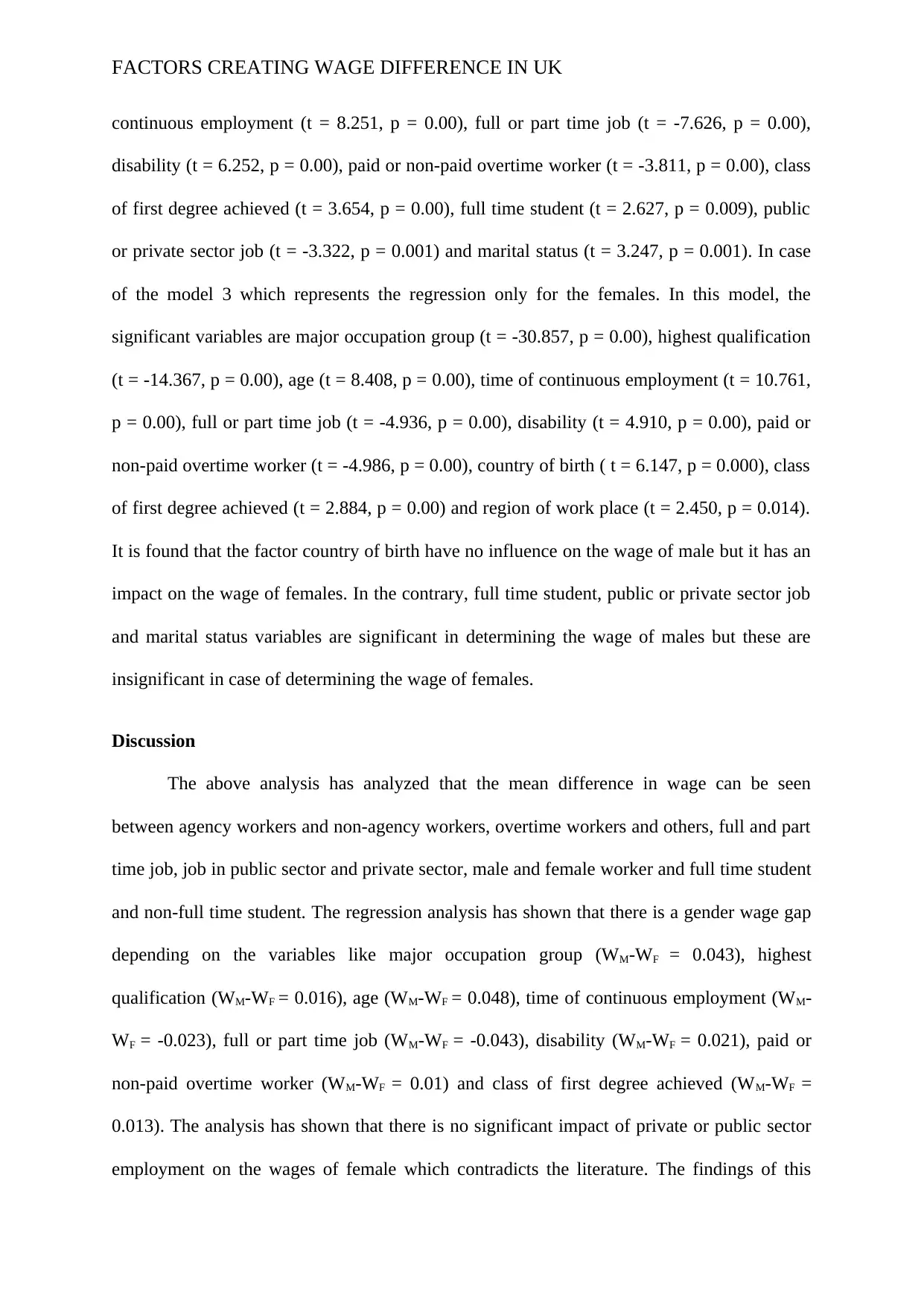
FACTORS CREATING WAGE DIFFERENCE IN UK
continuous employment (t = 8.251, p = 0.00), full or part time job (t = -7.626, p = 0.00),
disability (t = 6.252, p = 0.00), paid or non-paid overtime worker (t = -3.811, p = 0.00), class
of first degree achieved (t = 3.654, p = 0.00), full time student (t = 2.627, p = 0.009), public
or private sector job (t = -3.322, p = 0.001) and marital status (t = 3.247, p = 0.001). In case
of the model 3 which represents the regression only for the females. In this model, the
significant variables are major occupation group (t = -30.857, p = 0.00), highest qualification
(t = -14.367, p = 0.00), age (t = 8.408, p = 0.00), time of continuous employment (t = 10.761,
p = 0.00), full or part time job (t = -4.936, p = 0.00), disability (t = 4.910, p = 0.00), paid or
non-paid overtime worker (t = -4.986, p = 0.00), country of birth ( t = 6.147, p = 0.000), class
of first degree achieved (t = 2.884, p = 0.00) and region of work place (t = 2.450, p = 0.014).
It is found that the factor country of birth have no influence on the wage of male but it has an
impact on the wage of females. In the contrary, full time student, public or private sector job
and marital status variables are significant in determining the wage of males but these are
insignificant in case of determining the wage of females.
Discussion
The above analysis has analyzed that the mean difference in wage can be seen
between agency workers and non-agency workers, overtime workers and others, full and part
time job, job in public sector and private sector, male and female worker and full time student
and non-full time student. The regression analysis has shown that there is a gender wage gap
depending on the variables like major occupation group (WM-WF = 0.043), highest
qualification (WM-WF = 0.016), age (WM-WF = 0.048), time of continuous employment (WM-
WF = -0.023), full or part time job (WM-WF = -0.043), disability (WM-WF = 0.021), paid or
non-paid overtime worker (WM-WF = 0.01) and class of first degree achieved (WM-WF =
0.013). The analysis has shown that there is no significant impact of private or public sector
employment on the wages of female which contradicts the literature. The findings of this
continuous employment (t = 8.251, p = 0.00), full or part time job (t = -7.626, p = 0.00),
disability (t = 6.252, p = 0.00), paid or non-paid overtime worker (t = -3.811, p = 0.00), class
of first degree achieved (t = 3.654, p = 0.00), full time student (t = 2.627, p = 0.009), public
or private sector job (t = -3.322, p = 0.001) and marital status (t = 3.247, p = 0.001). In case
of the model 3 which represents the regression only for the females. In this model, the
significant variables are major occupation group (t = -30.857, p = 0.00), highest qualification
(t = -14.367, p = 0.00), age (t = 8.408, p = 0.00), time of continuous employment (t = 10.761,
p = 0.00), full or part time job (t = -4.936, p = 0.00), disability (t = 4.910, p = 0.00), paid or
non-paid overtime worker (t = -4.986, p = 0.00), country of birth ( t = 6.147, p = 0.000), class
of first degree achieved (t = 2.884, p = 0.00) and region of work place (t = 2.450, p = 0.014).
It is found that the factor country of birth have no influence on the wage of male but it has an
impact on the wage of females. In the contrary, full time student, public or private sector job
and marital status variables are significant in determining the wage of males but these are
insignificant in case of determining the wage of females.
Discussion
The above analysis has analyzed that the mean difference in wage can be seen
between agency workers and non-agency workers, overtime workers and others, full and part
time job, job in public sector and private sector, male and female worker and full time student
and non-full time student. The regression analysis has shown that there is a gender wage gap
depending on the variables like major occupation group (WM-WF = 0.043), highest
qualification (WM-WF = 0.016), age (WM-WF = 0.048), time of continuous employment (WM-
WF = -0.023), full or part time job (WM-WF = -0.043), disability (WM-WF = 0.021), paid or
non-paid overtime worker (WM-WF = 0.01) and class of first degree achieved (WM-WF =
0.013). The analysis has shown that there is no significant impact of private or public sector
employment on the wages of female which contradicts the literature. The findings of this
Paraphrase This Document
Need a fresh take? Get an instant paraphrase of this document with our AI Paraphraser
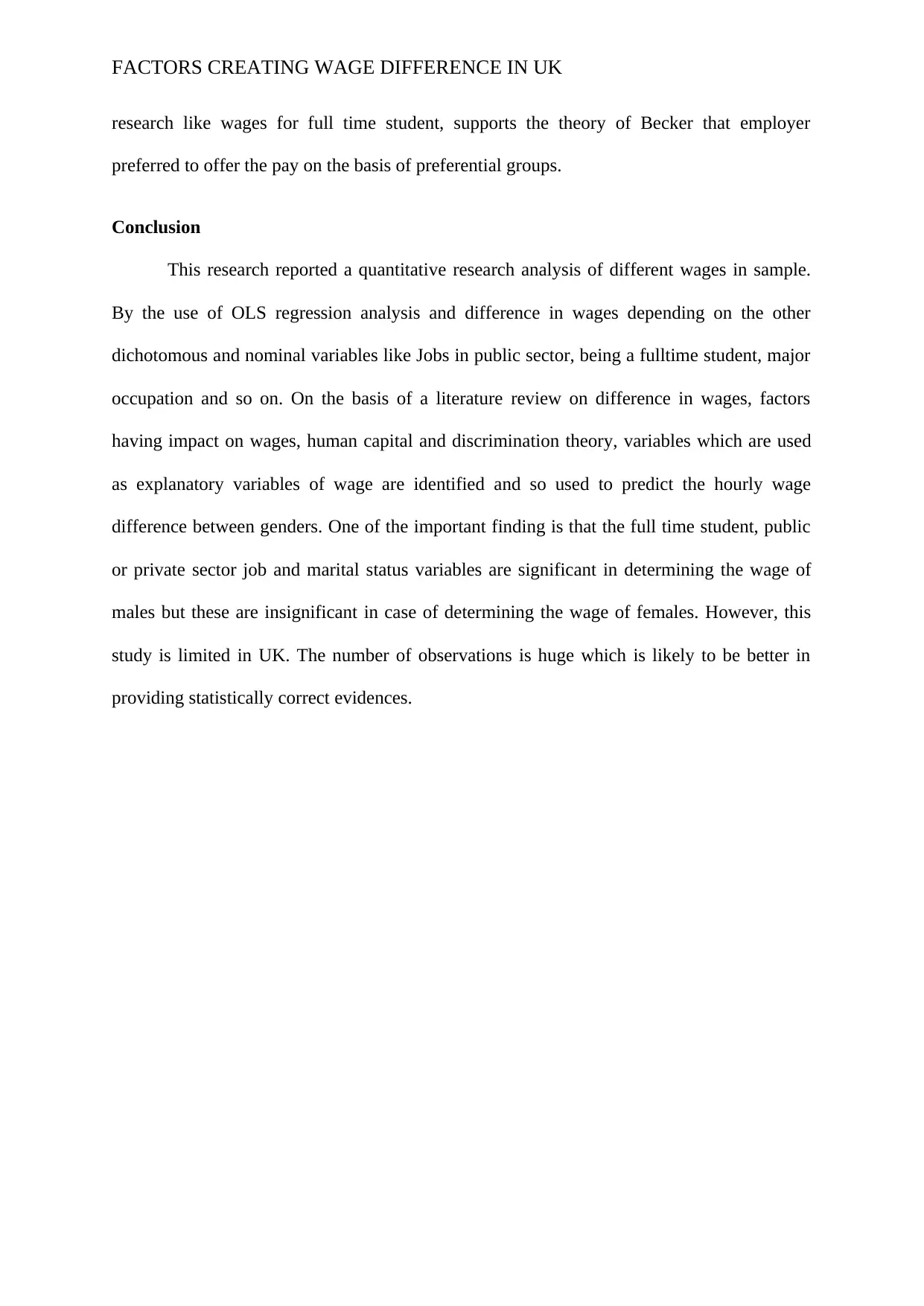
FACTORS CREATING WAGE DIFFERENCE IN UK
research like wages for full time student, supports the theory of Becker that employer
preferred to offer the pay on the basis of preferential groups.
Conclusion
This research reported a quantitative research analysis of different wages in sample.
By the use of OLS regression analysis and difference in wages depending on the other
dichotomous and nominal variables like Jobs in public sector, being a fulltime student, major
occupation and so on. On the basis of a literature review on difference in wages, factors
having impact on wages, human capital and discrimination theory, variables which are used
as explanatory variables of wage are identified and so used to predict the hourly wage
difference between genders. One of the important finding is that the full time student, public
or private sector job and marital status variables are significant in determining the wage of
males but these are insignificant in case of determining the wage of females. However, this
study is limited in UK. The number of observations is huge which is likely to be better in
providing statistically correct evidences.
research like wages for full time student, supports the theory of Becker that employer
preferred to offer the pay on the basis of preferential groups.
Conclusion
This research reported a quantitative research analysis of different wages in sample.
By the use of OLS regression analysis and difference in wages depending on the other
dichotomous and nominal variables like Jobs in public sector, being a fulltime student, major
occupation and so on. On the basis of a literature review on difference in wages, factors
having impact on wages, human capital and discrimination theory, variables which are used
as explanatory variables of wage are identified and so used to predict the hourly wage
difference between genders. One of the important finding is that the full time student, public
or private sector job and marital status variables are significant in determining the wage of
males but these are insignificant in case of determining the wage of females. However, this
study is limited in UK. The number of observations is huge which is likely to be better in
providing statistically correct evidences.
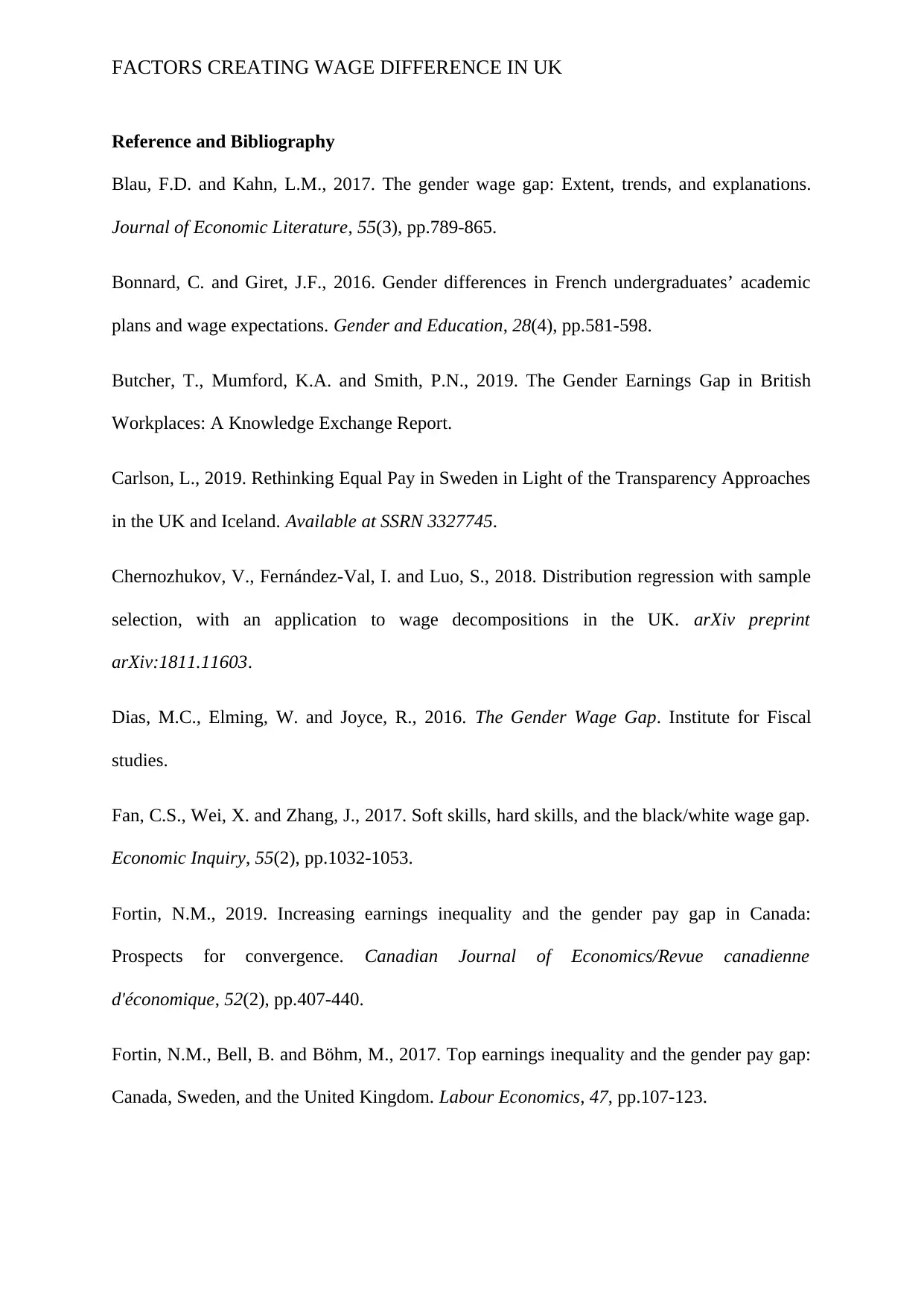
FACTORS CREATING WAGE DIFFERENCE IN UK
Reference and Bibliography
Blau, F.D. and Kahn, L.M., 2017. The gender wage gap: Extent, trends, and explanations.
Journal of Economic Literature, 55(3), pp.789-865.
Bonnard, C. and Giret, J.F., 2016. Gender differences in French undergraduates’ academic
plans and wage expectations. Gender and Education, 28(4), pp.581-598.
Butcher, T., Mumford, K.A. and Smith, P.N., 2019. The Gender Earnings Gap in British
Workplaces: A Knowledge Exchange Report.
Carlson, L., 2019. Rethinking Equal Pay in Sweden in Light of the Transparency Approaches
in the UK and Iceland. Available at SSRN 3327745.
Chernozhukov, V., Fernández-Val, I. and Luo, S., 2018. Distribution regression with sample
selection, with an application to wage decompositions in the UK. arXiv preprint
arXiv:1811.11603.
Dias, M.C., Elming, W. and Joyce, R., 2016. The Gender Wage Gap. Institute for Fiscal
studies.
Fan, C.S., Wei, X. and Zhang, J., 2017. Soft skills, hard skills, and the black/white wage gap.
Economic Inquiry, 55(2), pp.1032-1053.
Fortin, N.M., 2019. Increasing earnings inequality and the gender pay gap in Canada:
Prospects for convergence. Canadian Journal of Economics/Revue canadienne
d'économique, 52(2), pp.407-440.
Fortin, N.M., Bell, B. and Böhm, M., 2017. Top earnings inequality and the gender pay gap:
Canada, Sweden, and the United Kingdom. Labour Economics, 47, pp.107-123.
Reference and Bibliography
Blau, F.D. and Kahn, L.M., 2017. The gender wage gap: Extent, trends, and explanations.
Journal of Economic Literature, 55(3), pp.789-865.
Bonnard, C. and Giret, J.F., 2016. Gender differences in French undergraduates’ academic
plans and wage expectations. Gender and Education, 28(4), pp.581-598.
Butcher, T., Mumford, K.A. and Smith, P.N., 2019. The Gender Earnings Gap in British
Workplaces: A Knowledge Exchange Report.
Carlson, L., 2019. Rethinking Equal Pay in Sweden in Light of the Transparency Approaches
in the UK and Iceland. Available at SSRN 3327745.
Chernozhukov, V., Fernández-Val, I. and Luo, S., 2018. Distribution regression with sample
selection, with an application to wage decompositions in the UK. arXiv preprint
arXiv:1811.11603.
Dias, M.C., Elming, W. and Joyce, R., 2016. The Gender Wage Gap. Institute for Fiscal
studies.
Fan, C.S., Wei, X. and Zhang, J., 2017. Soft skills, hard skills, and the black/white wage gap.
Economic Inquiry, 55(2), pp.1032-1053.
Fortin, N.M., 2019. Increasing earnings inequality and the gender pay gap in Canada:
Prospects for convergence. Canadian Journal of Economics/Revue canadienne
d'économique, 52(2), pp.407-440.
Fortin, N.M., Bell, B. and Böhm, M., 2017. Top earnings inequality and the gender pay gap:
Canada, Sweden, and the United Kingdom. Labour Economics, 47, pp.107-123.
⊘ This is a preview!⊘
Do you want full access?
Subscribe today to unlock all pages.

Trusted by 1+ million students worldwide
1 out of 57
Related Documents
Your All-in-One AI-Powered Toolkit for Academic Success.
+13062052269
info@desklib.com
Available 24*7 on WhatsApp / Email
![[object Object]](/_next/static/media/star-bottom.7253800d.svg)
Unlock your academic potential
Copyright © 2020–2025 A2Z Services. All Rights Reserved. Developed and managed by ZUCOL.





